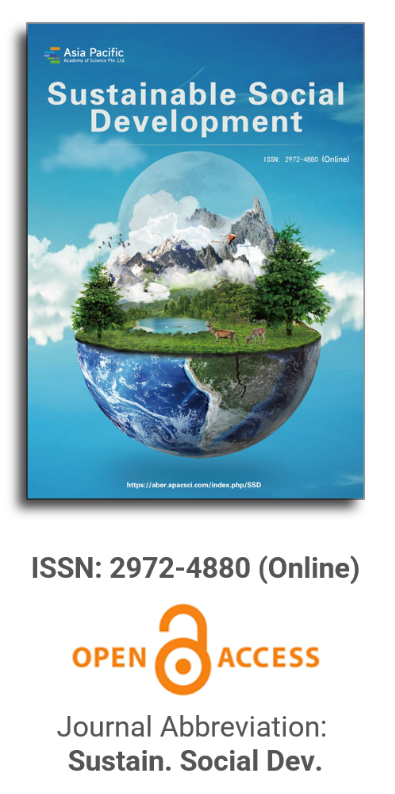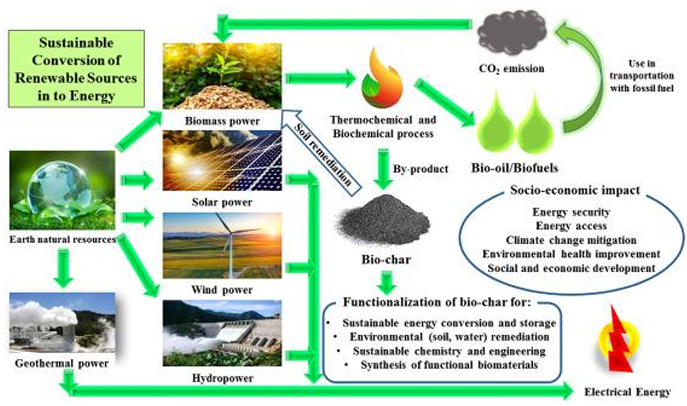
Asia Pacific Academy of Science Pte. Ltd. (APACSCI) specializes in international journal publishing. APACSCI adopts the open access publishing model and provides an important communication bridge for academic groups whose interest fields include engineering, technology, medicine, computer, mathematics, agriculture and forestry, and environment.

Welcome to Volume 2, Issue 5 of Sustainable Social Development. This issue will bring readers sustainable development research in business, transportation planning, and resource utilization. Among them, 3D printing technology and condensate recovery offer environmental benefits and energy savings, both of which are of importance to achieving sustainable development. Furthermore, this issue underscores the importance of gender equality in accomplishing sustainable development goals, which helps women gain more legitimate rights and interests.
Full Issue
| View or download the full issue |
Issue release: 31 October 2024
Freshwater is essential for everyday activities including drinking, irrigation, farming and many industrial processes. However, freshwater is less than 1% of the total water resources in the planet and, therefore, it is considered a very valuable commodity. Limited resources and growing needs for freshwater triggered global exploration for alternatives to produce enough freshwater for human needs. Today’s most widely used methods to produce freshwater is desalination. However, critical appraisal of the desalination procedures raised the alarm about sustainability of desalination and indicated that significant research is needed to develop alternative green resources of freshwater. Countries in the Gulf area such as Oman and UAE experience hot and humid climates and use air-conditioning units to achieve acceptable comfort levels and create a healthier indoor environment. The cooling process release a large amount of condensate water through cooling coils. This amount of water is usually considered as a problem rather than opportunity and, thus, is wasted into municipal sewerage systems via a system of drainage pipes. This alternative source can be utilized in various drainage, irrigation, and cooling applications to reduce the use of considerable amount of municipal potable water. This source not only takes part in controlling the water scarcity, but also in saving energy and to reducing the carbon footprint. This paper focus on highlighting the opportunities for Oman and UAE to utilize the condensate water from air-conditioning process, as a viable alternative source of green fresh water. It provides a comparison of the potentials of both countries to collect condensate water, based on meteorological data, location and climate. It was concluded that both countries have great potentials and opportunities to utilize this wasted resource.
Issue release: 31 October 2024
This study assessed genders’ institutional level of arrangement in REDD+ pilot sites, Cross River State, Nigeria. Data were collected through literature and policy document review and Focus Group Discussion (FGD). The total number of 270 documents with three, Level 1: Non-substantive inclusion, Level 2: Superficial inclusion and Level 3: Integrated inclusion. The gender were classified as Men and Women for the search engine. The results showed that only 95 of the 270 REDD+ related documents mentioned gender (representing 51% of the total documents). Nearly half of the texts that include the crucial phrases were categorized at Level 1, which means that gender concerns were not material. Regardless of how it is seen, the meager inclusion of gender mainstreaming discussion can only be found in Level 3. This 7% translated to only 12 out of the 270 documents which truly and fully understood the gender mainstreaming ideas. The study concluded that communities’ policy interventions such as REDD+ still exhibit non-compliance of gender mainstreaming and institutional level of arrangement, therefore, this study recommend that “sincerity” of gender mainstreaming from the government and other stakeholders is a panacea for the success of any climate change adaptation programme such as REDD+.
Issue release: 31 October 2024
Gender and mobility are strongly related and address challenges of safety and accessibility for women. Studies worldwide highlight the need to create more gender-responsive transport systems that maximize women’s mobility, civic participation, and safety. Gender inequality in urban transport is evident in Indian cities in terms of women’s longer walking trip lengths, longer time spent in commute and hence time poverty, impoverished health, and compromised personal safety. Even the public transport systems, often perceived as more gender-equal, overlook women’s needs and mobility concerns such as affordability and scheduling. This article presents transportation challenges faced by women (recorded through primary surveys and focus-group discussions) and further investigates how low-carbon urban transport, as perceived under the Paris Agreement and Sustainable Development Goals (SDGs), can be delivered with gender-equitable outcomes. For a more holistic perspective, the assessment is grounded in two Indian cities, Surat (4.5 million population), a fast-growing industrial metropolis, and Udaipur (0.5 million population), a small but important tourist destination in the nation.
Issue release: 31 October 2024
This study investigates the impact of planned tram lines on walkability and accessibility in Sakarya, utilizing Geographic Information Systems (GIS) for spatial analysis. The research evaluates the catchment areas of proposed tram stops, assessing their suitability and coverage, and examines how these areas integrate with existing public transport routes. By calculating time-oriented catchments for 5, 8, and 10-minute walking distances, the study identifies service gaps and redundancies in the public transport network. The findings reveal that the new tram lines will enhance accessibility by extending coverage to high-density areas and potentially reducing the demand on existing bus services. The analysis also highlights the overlap between bus transit lines and tram stops, suggesting optimizations to improve network efficiency. The results offer valuable insights for urban planners, aiming to optimize Sakarya’s public transport system to be more inclusive and sustainable. This study contributes to urban mobility planning by providing a detailed understanding of how new tram lines can improve connectivity and support sustainable urban development.
Issue release: 31 October 2024
This study investigates the impact of sustainable sourcing practices on firm performance and stakeholder satisfaction across various industries. Using a quantitative approach, data were collected from 500 firms through a structured survey questionnaire. The findings reveal that sustainable sourcing practices lead to a significant positive impact on firm performance, with an average 15% increase in profitability and 20% improvement in stakeholder satisfaction scores. The regression analysis shows a strong correlation (r = 0.45, p < 0.001) between sustainable sourcing and enhanced firm outcomes. The study identifies firm size, industry type, and sustainability awareness as critical factors influencing the adoption of sustainable practices. Recommendations include integrating sustainability into procurement processes to enhance long-term performance. Future research should explore the longitudinal effects of these practices across different market conditions.
Issue release: 31 October 2024
The ability to solve real-world problems for a sustainable future has become a worldwide consensus, and interdisciplinary competencies and project-based learning (PBL) have become the focus of curriculum reform in China. This study investigates the effectiveness of interdisciplinary PBL fieldwork in geography education for sustainable development, focusing on the perceptions of students from a junior high school in Chongming, Shanghai, of the interdisciplinary effectiveness of PBL fieldwork. Over a one-month pilot program, the results suggest that the new fieldwork approach did not achieve the expected benefits. The significant gains of students can be grouped into four perspectives, namely, understanding of nature and classroom knowledge; problem-solving skills and environmental action; scientific spirit, environmental awareness, and interest in geography; and understanding of local needs and sustainable development issues, which increased their interest in learning. The students generally accepted the ability to collect information and data and the thinking ability of circular development. The influencing factors of activity effectiveness include the time and difficulty of the activity, cognitive and knowledge levels, learning habits of students, student participation, and teaching experience of teachers. The study offers valuable insights for improving fieldwork in other regions and for future research.
Issue release: 31 October 2024
This study aims to explore how digital transformation can promote sustainable development. Specifically, this paper makes an in-depth analysis from the perspective of theory and practice, in order to provide a solid theoretical basis and effective practical guidance for sustainable development, and help the coordinated progress of economy, society and environment. The primary characteristics of digital transformation include being data-driven, real-time interconnected, automated and intelligent, and customer-oriented. Digital transformation can contribute to sustainable development across various industries, ranging from industrial manufacturing to agriculture, energy, and urban development, all of which have seen practical outcomes. In the industrial manufacturing sector, digital transformation can enhance production efficiency, reduce energy consumption, and minimize waste emissions. In agriculture, it can enable precision farming and smart agriculture, thereby improving agricultural productivity and sustainability. In the energy sector, digital transformation can achieve clean, efficient, and renewable energy production. In urban development, it can facilitate the construction of smart and sustainable cities, improving urban environmental quality and residents’ quality of life. Government, businesses, and society all play crucial roles in driving digital transformation forward.
Issue release: 31 October 2024
3D printing has fundamentally transformed traditional manufacturing practices by enabling decentralized production, customization, and significant reductions in waste and energy consumption. This paper provides a thorough examination of the advancements, applications, challenges, and future prospects of 3D printing in fostering sustainable manufacturing practices across diverse industries. Key additive manufacturing technologies such as Fused Deposition Modeling (FDM), Stereolithography (SLA), Selective Laser Sintering (SLS), and Direct Metal Laser Sintering (DMLS) are discussed in relation to their role in achieving sustainability goals. The versatility of 3D printing materials, including biodegradable polymers, recycled metals, and eco-friendly composites, is highlighted alongside their environmental benefits and functional advantages in sectors such as automotive, healthcare, construction, consumer products, electronics, aerospace, and defense. Despite the transformative potential of 3D printing, challenges such as material limitations, energy consumption, regulatory compliance, and initial costs persist, requiring collaborative efforts to overcome. Looking ahead, ongoing research and development efforts in materials science, process optimization, and Industry 4.0 integration are poised to further enhance the sustainability and scalability of 3D printing technologies, thereby paving the way for a more environmentally conscious and economically viable manufacturing future.

Prof. Kittisak Jermsittiparsert
University of City Island, Cyprus






It is with deep regret that we announce the cancellation of the Forum on Sustainable Social Development & Computing and Artificial Intelligence, originally scheduled for June 15, 2025.


 Open Access
Open Access